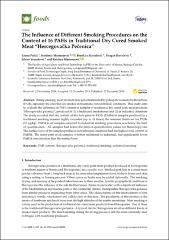The Influence of Different Smoking Procedures on the Content of 16 PAHs in Traditional Dry Cured Smoked Meat “Hercegovačka Pečenica”

View/
Date
2019Author
Puljić, Leona
Mastanjević, Krešimir
Kartalović, Brankica
Kovačević, Dragan
Vranešević, Jelena
Mastanjević, Kristina
Metadata
Show full item recordAbstract
During smoking, meat products may get contaminated by polycyclic aromatic hydrocarbons
(PAH), especially the ones that are smoked in traditional (uncontrolled) conditions. This study aims
to evaluate the difference in PAH content in samples of traditional dry cured pork meat products,
“Hercegovaˇcka peˇcenica”, produced in (1) a traditional smokehouse and (2) in industrial chambers.
The study revealed that the content of the four priority PAHs (PAH4) in samples produced in a
traditional smoking manner highly exceeded (up to 10 times) the maximal limits set for PAHs
(12 µg/kg). PAH4 in all samples subjected to industrial smoking procedures was below the limit
of quantification. All samples had below-the-limit-of-quantification values for Benzo[a]pyrene.
The surface layer of the samples produced in traditional conditions had the highest total content of
PAH16. The inner parts of all samples, whether traditional or industrial, had significantly lower
PAH16 concentration than the surface layer
